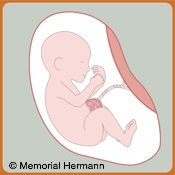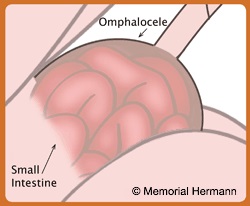What Is an Omphalocele?

An omphalocele occurs when some of the fetal abdominal contents develop outside of the abdomen in a transparent sac at the base of the umbilical cord. It is normal for the organs to develop outside of the abdomen up until the tenth week of pregnancy, but if they do not return to the abdomen following that period, an omphalocele may develop. The omphalocele may also contain one or several organs.
Omphaloceles occur in approximately one in every 5,000 live births. In many cases, the presence of an omphalocele is associated with other health problems, particularly heart defects, chromosomal abnormalities, fetal growth abnormalities, and preterm delivery.
Omphalocele Prenatal Care Algorithm PDF
Omphaloceles are similar to gastroschisis, but the two conditions have important differences. For more information, please see the section on gastroschisis.
What Will Happen During Pregnancy?
An omphalocele is usually diagnosed by prenatal ultrasound. If one is detected, a series of ultrasounds will be performed throughout pregnancy to determine the extent of the omphalocele, the location and structure of other fetal organs, and to assess fetal growth. In particular, a specialized ultrasound of the fetal heart, called an echocardiogram, will be performed and an amniocentesis will be recommended to look for chromosomal anomalies.
How is Omphalocele Treated?
Will a Fetal Treatment Be Required?
Omphaloceles do not require fetal intervention. However, the fetal team will develop a plan for you and your infant before, during, and after delivery to ensure a smooth transition for your newborn.
What Special Considerations Should Be Made for Delivery?
Type of delivery: Typically, an omphalocele does not require cesarean delivery. If an extremely large omphalocele is present, a Cesarean delivery may be recommended in order to minimize the risk of damage to the sac during delivery. The delivery plan should be carefully discussed between the mother and her obstetrician.
Place of delivery: The baby should be delivered at a hospital that is well prepared to handle the intensive care and surgery required of infants with an omphalocele. There should be a neonatal intensive care unit with the capability to provide specialized care and pediatric surgery services.
Time of delivery: Unless the omphalocele sac has ruptured inside the mother's amniotic sac, there is no reason to intentionally induce early delivery. If the omphalocele has ruptured, the obstetrician may advise an early delivery to minimize the risk of infection or damage. However, most infants will benefit from continuing pregnancy to term.
What Will Happen at Birth?

What Will Happen After Delivery?
If the omphalocele is small, surgery may take place within the first few days following delivery. A larger omphalocele may require a longer stay in the neonatal intensive care unit so that the abdominal cavity can expand enough to hold the organs that developed in the omphalocele sac. The surgeon will determine the safest time to surgically repair the omphalocele. A large omphalocele may require special treatment to the sac in order for normal skin to grow onto it. As long as the sac remains intact, surgery can be delayed until the baby grows bigger. Typically, it will be several weeks before the baby's intestinal tract functions normally. The baby will be fed by intravenously through total parenteral nutrition (TPN) until normal bowel function returns.
What Are the Long-Term Outcomes and Considerations?
Complications and long-term health effects depend greatly on the size of the omphalocele and the presence of other health issues. Following post-delivery care and repair, most babies born with a small omphalocele will mature normally and should experience minimal life-long complications related to the actual omphalocele. Very large omphaloceles may require several operations over years to ultimately complete the repair. Most health issues are related to other major health problems that can occur along with omphalocele.
Contact Us
When you contact The Fetal Center, you will be in touch with a dedicated coordinator who will walk you through the process step-by-step and help you to understand every aspect of your care.
The Fetal Center at Children's Memorial Hermann Hospital
UT Professional Building
6410 Fannin, Suite 210
Houston, Texas 77030
Phone: (832) 325-7288
Toll free: (888) 818-4818
Fax: (713) 383-1464
Email: thefetalcenter@memorialhermann.org
To contact The Fetal Center at Children's Memorial Hermann Hospital, please fill out the form below.
Located within the Texas Medical Center, The Fetal Center is affiliated with McGovern Medical School at UTHealth Houston, UT Physicians and Children’s Memorial Hermann Hospital.